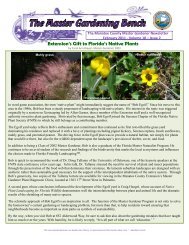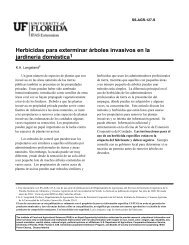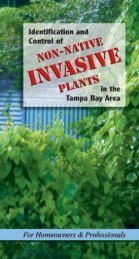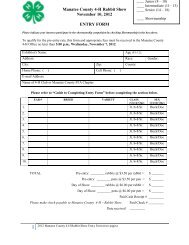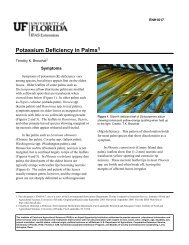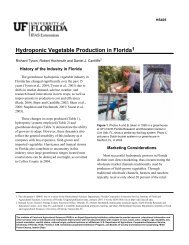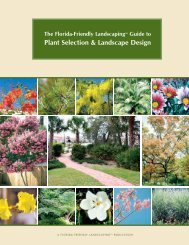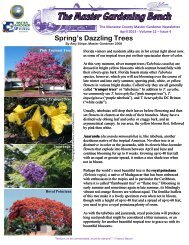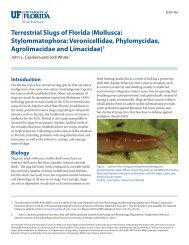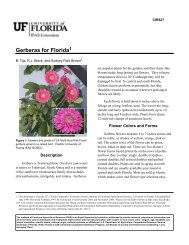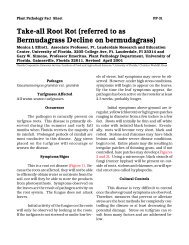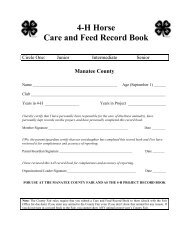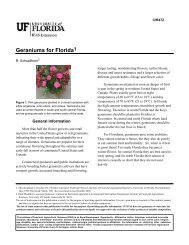Petiole (Rachis) Blight of Palm - Manatee County Extension Office ...
Petiole (Rachis) Blight of Palm - Manatee County Extension Office ...
Petiole (Rachis) Blight of Palm - Manatee County Extension Office ...
You also want an ePaper? Increase the reach of your titles
YUMPU automatically turns print PDFs into web optimized ePapers that Google loves.
PP-221<strong>Petiole</strong> (<strong>Rachis</strong>) <strong>Blight</strong> <strong>of</strong> <strong>Palm</strong> 1Monica L. Elliott 2Summary• <strong>Petiole</strong> (rachis) blight is caused by numerousfungal pathogens, but the symptoms thesepathogens cause are similar for all <strong>of</strong> them.• <strong>Palm</strong> host range is unknown for this disease.• The disease <strong>of</strong>ten results in discolored (usuallybrown or reddish-brown) elongated lesions orstreaks along the petiole <strong>of</strong> the oldest (lowest)leaves.• The pathogens infect only the petiole, not theleaf tissue. However, destruction <strong>of</strong> vasculartissue (xylem and phloem) deep into the petioleresults in a one-sided or uneven death in the leafblade.• Fungal structures can sometimes be observedon the infected petiole surface.• Since very little is known about this disease,only general disease management strategiesregarding sanitation, water management, andfungicide use can be provided.IntroductionTo discuss petiole (rachis) blight, a briefintroduction to palm leaf anatomy is required. Thereare three types <strong>of</strong> palm leaves. All possess a base(leaf sheath), a petiole and a blade. The leaf base isthe portion that attaches to the stem (trunk). The leafpetiole is the stalk or stem <strong>of</strong> the leaf connecting theleaf base with the leaf blade.The leaf blade is either: 1) fan-like (palmate)with individual leaflets (segments) merged togetherand the petiole terminated where the blade begins; 2)an elongated version <strong>of</strong> fan-like (costapalmate) withindividual leaflets (segments) merged together butwith the petiole extending into the leaf blade; or 3)feather-like (pinnate) with individual leaflets clearlydelineated and attached to the petiole, with the petioleextending the entire length <strong>of</strong> the leaf blade. Theextension <strong>of</strong> the petiole into the leaf blade is calledthe “costa” on a costapalmate palm, and the“rachis” on a pinnate palm.Unfortunately, the term petiole and rachis are<strong>of</strong>ten used interchangeably. Since diseases <strong>of</strong> thepetiole were first observed on Phoenix palms,pinnate-leaf palms that have a rachis, the common1. This document is Fact Sheet PP-221, one <strong>of</strong> a series <strong>of</strong> the Plant Pathology Department, Florida Cooperative <strong>Extension</strong> Service, Institute <strong>of</strong> Food andAgricultural Sciences, University <strong>of</strong> Florida. Original publication date January 2006. Visit the EDIS Web Site at http://edis.ifas.ufl.edu.2. M. L. Elliott, pr<strong>of</strong>essor, Plant Pathology Department, Fort Lauderdale Research and Education Center--Ft. Lauderdale, FL; Florida Cooperative <strong>Extension</strong>Service, Institute <strong>of</strong> Food and Agricultural Sciences, University <strong>of</strong> Florida, Gainesville, FL.The use <strong>of</strong> trade names in this publication is solely for the purpose <strong>of</strong> providing specific information. UF/IFAS does not guarantee or warranty theproducts named, and references to them in this publication does not signify our approval to the exclusion <strong>of</strong> other products <strong>of</strong> suitable composition.The Institute <strong>of</strong> Food and Agricultural Sciences (IFAS) is an Equal Opportunity Institution authorized to provide research, educational information andother services only to individuals and institutions that function with non-discrimination with respect to race, creed, color, religion, age, disability, sex,sexual orientation, marital status, national origin, political opinions or affiliations. U.S. Department <strong>of</strong> Agriculture, Cooperative <strong>Extension</strong> Service,University <strong>of</strong> Florida, IFAS, Florida A. & M. University Cooperative <strong>Extension</strong> Program, and Boards <strong>of</strong> <strong>County</strong> Commissioners Cooperating. LarryArrington, Dean
<strong>Petiole</strong> (<strong>Rachis</strong>) <strong>Blight</strong> <strong>of</strong> <strong>Palm</strong> 2name <strong>of</strong> these diseases became “rachis blight.”However, as we now know, palms that do not have arachis also are susceptible to petiole diseases. In thisfact sheet the disease will be referred to as "petioleblight."In general, the “typical” or “classic” petioleblight is a disease in which the pathogen only infectsthe petiole. The disease symptoms may look like thepathogen has also infected the leaf blade, but this is asecondary affect from petiole infection. Anexception to the “typical” petiole blight is a diseasecaused by Pestalotiopsis. This pathogen causes botha leaf spot and blight as well as a petiole or rachisblight, usually at the same time. It is discussed in aseparate fact sheet at http://edis.ifas.ufl.edu/pp141.Pathogens and HostsThere are a number <strong>of</strong> different pathogensassociated with petiole blight. These includeCocoicola and Serenomyces, which are only found inassociation with palms. Macrophoma, Phoma,Phomopsis, Diplodia, and Pestalotiopsis may alsocause this disease, but these fungi also cause diseases<strong>of</strong> numerous other plant hosts. The host range <strong>of</strong> all<strong>of</strong> these fungi within the palm family is unknown.SymptomsFigure 1. Overview <strong>of</strong> Washingtonia robusta group: Thecenter palm is severely affected by <strong>Petiole</strong> <strong>Blight</strong> causedby Cocoicola. Credits: A. Wilsondestroyed vascular tissue are killed (Figure 4). Thisresults in a one-sided or uneven death <strong>of</strong> the leafblade, the symptom most <strong>of</strong>ten observed first. ForPhoenix canariensis (Canary Island date palm), thesesymptoms are quite similar to those caused byFusarium wilt. See the fact sheet on this disease athttp://edis.ifas.ufl.edu/pp139.Mature palms (palms with trunks) are morelikely to be affected by petiole blight than juvenilepalms. On mature palms, the oldest (lowest) livingleaves will be affected first. The disease will move upthrough the canopy to younger leaves. The diseasemay severely debilitate the palm, but the diseaseseldom kills the palm (Figure 1).No matter which pathogen is causing the disease,the symptoms <strong>of</strong> petiole blight are essentially thesame. Discolored (usually brown or reddish-brown)elongated lesions or streaks <strong>of</strong>ten occur along thepetiole and rachis (Figures 2 and 3). The fungusinvades deep into the petiole and is destroying alltissue, including the vascular tissue (xylem andphloem). This vascular tissue moves water andcarbohydrates between the leaf and the stem (trunk).Vascular tissue destroyed in the petiole or rachisresults in localized death in the leaf blade becauseonly the leaf segments or leaflets connected to theFigure 2. Reddish-brown streak along petiole <strong>of</strong>Washingtonia robusta due to <strong>Petiole</strong> <strong>Blight</strong>. Credits: A.WilsonAgain, while it appears the fungus is alsoinfecting the leaf blade, it does not. The leaf bladesymptoms are a result <strong>of</strong> the fungal damage in the
<strong>Petiole</strong> (<strong>Rachis</strong>) <strong>Blight</strong> <strong>of</strong> <strong>Palm</strong> 3Figure 3. Close-up <strong>of</strong> discolored petiole streak shown inFigure 2. Credits: M.L. ElliottFigure 5. Sporulating structures <strong>of</strong> Cocoicola on aWashingtonia robusta petiole. Credits: M.L. ElliottDiagnosisFigure 4. Reddish-brown lesion on petiole disruptsvascular tissue which kills leaflets within the leaf blade.Credits: M.L. Elliottpetiole and rachis. Thus, for diagnostic purposes, thepetiole or rachis is the tissue that must be examinedand sampled, and not the leaf blade. A cross-sectionthrough the petiole or rachis lesion or streak willreveal the discolored internal tissue resulting fromthe fungal invasion. It is critical to use a saw to cutthrough the petiole or rachis. A tool such as a pruningshear may bruise internal, healthy plant tissue in thecutting process. This bruise can then be mistaken forfungal damage.Sometimes, the surface <strong>of</strong> the diseased petiole orrachis will have erupted with fungal structures whilethe leaf is still attached to the palm trunk (Figure 5).These structures either are or can be induced toproduce spores used to identify the pathogen.As stated above, fungal structures may bepresent on the petiole or rachis at the time thesymptoms are observed. These structures may also besporulating while the leaf is still attached to the trunk,which makes pathogen identification relativelysimple. If not producing spores, it is usually possibleto induce spore production. If these structures are notimmediately evident, placement <strong>of</strong> the diseasedpetiole segment into a moist chamber (e.g., sealedplastic container with wet paper toweling) will <strong>of</strong>teninduce their development (Figure 6).Figure 6. Sporulating structures <strong>of</strong> fungus causing<strong>Petiole</strong>/<strong>Rachis</strong> <strong>Blight</strong> on Latania. This piece was incubatedfor two weeks before the structures appeared. Credits:M.L. ElliottWhile some <strong>of</strong> the pathogens that cause petioleblight can be cultured on artificial media, manycannot. The Florida <strong>Extension</strong> Plant Disease Clinic(FEPDC) network is available for pathogenidentification. Contact your local county <strong>Extension</strong>
<strong>Petiole</strong> (<strong>Rachis</strong>) <strong>Blight</strong> <strong>of</strong> <strong>Palm</strong> 4<strong>of</strong>fice or FEPDC for information on samplesubmission and cost <strong>of</strong> laboratory diagnosis. Ingeneral, the entire leaf should be placed in acardboard box or tube and padded with dry paper.The leaf can be cut into pieces with a handsaw foreasier packaging. Do not place the pieces in a plasticbag.Disease ManagementVery little is known about petiole blight,including the specific environmental conditions thatencourage disease development. It is presumed thathigh humidity is required for fungal infection anddisease development, as that is a requirement formany plant diseases that affect above-ground tissue.It is also presumed that spores are the primary means<strong>of</strong> fungal movement from palm to palm. Based onthese assumptions, sanitation and water managementare the basis for petiole blight management.Removal and destruction <strong>of</strong> severely infectedleaf fronds would be suggested as a means <strong>of</strong>reducing inoculum (available spores to infect otherleaves and palms). This would be especially criticalin a nursery situation where palms are planted closertogether and are more numerous. However, if thepalms are in the landscape and under nutrient stress,pruning should be minimal as removal <strong>of</strong> too manyleaves may be detrimental to the palm rather thanbeneficial.In a nursery, increasing distance between plants,increasing air movement, and irrigating in the earlymorning hours to reduce leaf wetness at night arecritical water management components. Whenpossible, overhead irrigation should be eliminated.fungicide sprays to protect the petiole and rachis maybe useful. For palms where the canopy is no longeraccessible, broad-spectrum systemic fungicide soildrenches may be useful, although information as tomovement <strong>of</strong> systemic fungicides in palms isextremely limited.It is critical to understand that fungicides do notcure the damage already present on the palm. Planttissue does not “heal” itself. Once the damageoccurs, it will remain for the duration <strong>of</strong> the life <strong>of</strong>that particular leaf. Fungicides are used to preventfurther spread <strong>of</strong> the disease by protecting a leafpetiole and rachis that has not yet been infected by thefungal pathogen.Selected ReferencesBarr, M. E., H. D. Ohr, and M. K. Murphy.1989. The genus Serenomyces on palms.Mycologia 81:47-51.Hyde, K. D., and P. F. Cannon. 1999. Fungicausing tar spots on palms. Mycologial Papers,No. 175. CABI Publishing, Wallingford, U.K.Simone, G. W. 2004. <strong>Rachis</strong> blight. Pages33-34 in: Compendium <strong>of</strong> Diseases andDisorders <strong>of</strong> Ornamental <strong>Palm</strong>s. M. L. Elliott, T.K. Broschat, J. Y. Uchida, and G. W. Simone,eds. American Phytopathological Society, St.Paul, MN.Simone, G. W. 1998. Prevention andmanagement <strong>of</strong> palm diseases in Floridaslandscapes. PP-Mimeo 98-4. FloridaCooperative <strong>Extension</strong> Service, Gainesville, FL.Since no fungicides have been evaluated forefficacy in managing petiole blight, fungiciderecommendations are educated guesses at best.Fungicides would only be recommended in thosesituations where a palm is being seriously affected, orthe potential for an epidemic is high, such as in anursery. Never initiate a fungicide program withoutfirst initiating a cultural control program as describedabove.For palms where the canopy is still accessible forspraying, broad-spectrum contact or systemic foliar



